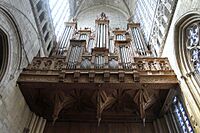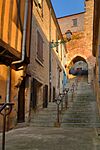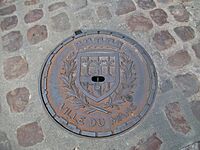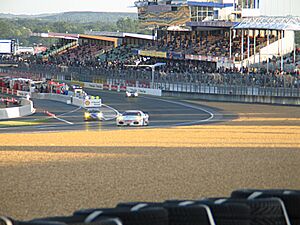Le Mans facts for kids
Quick facts for kids
Le Mans
|
||
|---|---|---|
|
Prefecture and commune
|
||
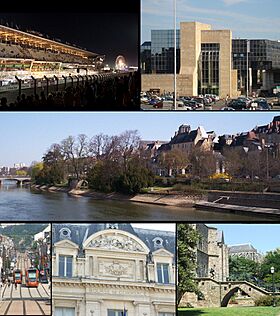
Top row: left, Le Mans 24-hr automobile race in June; right, Le Mans Justice Department Office; Middle row: View of Sarthe River and historic area, including the Palais of Comtes du Maine; Bottom row: left, Le Mans Tramway in Gambetta Street; center, Facade built in Le Mans Commerce Center; right, Saint Julien Cathedral
|
||
|
||
| Country | France | |
| Region | Pays de la Loire | |
| Department | Sarthe | |
| Arrondissement | Le Mans | |
| Canton | Le Mans-1, 2, 3, 4, 5, 6 and 7 | |
| Intercommunality | Le Mans Métropole | |
| Area
1
|
52.81 km2 (20.39 sq mi) | |
| Population
(2021)
|
145,004 | |
| • Density | 2,745.77/km2 (7,111.5/sq mi) | |
| Demonym(s) | Manceau (masculine) Mancelle (feminine) |
|
| Time zone | UTC+01:00 (CET) | |
| • Summer (DST) | UTC+02:00 (CEST) | |
| INSEE/Postal code |
72181 /72000
|
|
| Dialling codes | (0)243 | |
| Elevation | 38–134 m (125–440 ft) (avg. 51 m or 167 ft) |
|
| 1 French Land Register data, which excludes lakes, ponds, glaciers > 1 km2 (0.386 sq mi or 247 acres) and river estuaries. | ||
Le Mans (/lə ˈmɒ̃/, French: [lə mɑ̃]) is a cool city in northwestern France. It sits on the Sarthe River where it meets the Huisne. Le Mans is the capital of the Sarthe department. It is also part of the Pays de la Loire region.
People from Le Mans are called Manceaux (for boys and men) and Mancelles (for girls and women). Since 1923, the city has been famous for hosting the 24 Hours of Le Mans. This is the world's oldest and most famous endurance sports car race. It is one of the most exciting and important motor sports events anywhere!
Contents
History of Le Mans
Ancient Roman Times
Le Mans was first mentioned by the Roman writer Claudius Ptolemy. Back then, it was a Roman city called Vindinium. It was the main city for a tribe called the Aulerci. The Romans took control of the city in 47 BC.
You can still see parts of a Roman amphitheatre in Le Mans today. In the 3rd century, people built strong defensive walls around the city. These ancient walls are some of the most complete Roman city walls still standing.
Medieval Period
Le Mans became an important city in the region of Maine. In the 11th century, there were many fights for control of Le Mans. The counts of Anjou and the dukes of Normandy both wanted it.
When the Normans controlled Maine, William the Conqueror invaded England. Later, in 1069, the people of Maine fought back and kicked out the Normans.
A very important event happened in the cathedral. Geoffrey V of Anjou married Matilda of England there. Their son, Henry II Plantagenet, who later became King of England, was born in Le Mans.
In the 13th century, Le Mans became part of the French kingdom. But it was later invaded by England during the Hundred Years' War.
Modern Developments
In the 1800s, Le Mans grew a lot. Factories were built for railways, cars, textiles, and tobacco.
Aviation history was made here too! Wilbur Wright showed off his airplane near Le Mans on August 8, 1908. This was one of the first public flights of an airplane.
Le Mans in World War II
American soldiers from the 79th and 90th Infantry Divisions freed Le Mans on August 8, 1944. Soon after, engineers built an airfield outside the town. This airfield, called "A-35", helped American planes during the war.
Main Sights to See
Le Mans has many interesting places to visit:
- The old town, called Cité Plantagenêt or Vieux Mans, is very well-preserved. It feels like stepping back in time!
- The beautiful Cathédrale St-Julien is dedicated to St Julian of Le Mans, the city's first bishop.
- You can see parts of the ancient Roman wall in the old town. Roman baths are also located by the river. In summer evenings (July and August), these walls have a special light show that tells the city's history.
- The Arboretum de la Grand Prée is a lovely place with many different trees.
- Notre-Dame de la Couture is a medieval church.
- Notre Dame de Sainte Croix is a church built in the Neo-Gothic style.
- You can visit parts of the old Cistercian abbey de l'Epau. It was started by Queen Berengaria.
- The Jardin des Plantes du Mans is a pretty botanical garden.
- The Musée de la reine Bérengère is a museum about Le Mans history. It is located in an old Gothic manor house.
- The Musée de Tessé is the city's fine arts museum. It has paintings by famous artists like John Constable and Camille Corot. It also has ancient artifacts and decorative art.
Gallery
Climate of Le Mans
Le Mans has a mild oceanic climate (Cfb). This means it gets gentle air from the Atlantic Ocean. Summers are warm, sometimes hot, and winters are mild and cloudy. Rain falls pretty evenly throughout the year.
| Climate data for Le Mans (1991–2020 averages) | |||||||||||||
|---|---|---|---|---|---|---|---|---|---|---|---|---|---|
| Month | Jan | Feb | Mar | Apr | May | Jun | Jul | Aug | Sep | Oct | Nov | Dec | Year |
| Record high °C (°F) | 17.2 (63.0) |
21.8 (71.2) |
25.6 (78.1) |
30.3 (86.5) |
32.4 (90.3) |
39.7 (103.5) |
41.1 (106.0) |
40.5 (104.9) |
35.0 (95.0) |
30.0 (86.0) |
22.2 (72.0) |
18.3 (64.9) |
41.1 (106.0) |
| Mean maximum °C (°F) | 14.4 (57.9) |
16.2 (61.2) |
20.4 (68.7) |
24.8 (76.6) |
28.2 (82.8) |
32.4 (90.3) |
33.9 (93.0) |
34.0 (93.2) |
29.2 (84.6) |
23.5 (74.3) |
17.6 (63.7) |
14.3 (57.7) |
35.4 (95.7) |
| Mean daily maximum °C (°F) | 8.4 (47.1) |
9.7 (49.5) |
13.3 (55.9) |
16.6 (61.9) |
20.1 (68.2) |
23.6 (74.5) |
26.0 (78.8) |
26.0 (78.8) |
22.2 (72.0) |
17.2 (63.0) |
11.9 (53.4) |
8.8 (47.8) |
17.0 (62.6) |
| Daily mean °C (°F) | 5.5 (41.9) |
5.9 (42.6) |
8.7 (47.7) |
11.3 (52.3) |
14.9 (58.8) |
18.2 (64.8) |
20.3 (68.5) |
20.1 (68.2) |
16.7 (62.1) |
13.0 (55.4) |
8.6 (47.5) |
5.9 (42.6) |
12.4 (54.4) |
| Mean daily minimum °C (°F) | 2.7 (36.9) |
2.2 (36.0) |
4.0 (39.2) |
6.0 (42.8) |
9.7 (49.5) |
12.9 (55.2) |
14.6 (58.3) |
14.3 (57.7) |
11.2 (52.2) |
8.8 (47.8) |
5.2 (41.4) |
2.9 (37.2) |
7.9 (46.2) |
| Mean minimum °C (°F) | −6.1 (21.0) |
−5.1 (22.8) |
−3.0 (26.6) |
−0.6 (30.9) |
2.7 (36.9) |
6.8 (44.2) |
8.8 (47.8) |
7.7 (45.9) |
4.5 (40.1) |
0.8 (33.4) |
−2.8 (27.0) |
−5.2 (22.6) |
−8.0 (17.6) |
| Record low °C (°F) | −18.2 (−0.8) |
−17.0 (1.4) |
−11.3 (11.7) |
−4.9 (23.2) |
−3.7 (25.3) |
1.6 (34.9) |
3.9 (39.0) |
3.2 (37.8) |
−0.5 (31.1) |
−5.4 (22.3) |
−12.0 (10.4) |
−21.0 (−5.8) |
−21.0 (−5.8) |
| Average precipitation mm (inches) | 65.9 (2.59) |
49.1 (1.93) |
52.2 (2.06) |
51.1 (2.01) |
63.2 (2.49) |
55.1 (2.17) |
49.4 (1.94) |
49.0 (1.93) |
50.8 (2.00) |
65.5 (2.58) |
67.1 (2.64) |
75.0 (2.95) |
693.4 (27.29) |
| Average precipitation days | 11.0 | 9.6 | 9.4 | 9.0 | 9.5 | 7.9 | 7.3 | 7.1 | 7.7 | 10.6 | 11.3 | 11.6 | 112 |
| Average relative humidity (%) | 87 | 83 | 78 | 74 | 75 | 73 | 72 | 74 | 79 | 86 | 88 | 88 | 79.8 |
| Mean monthly sunshine hours | 65 | 94 | 139 | 180 | 207 | 221 | 233 | 226 | 185 | 118 | 75 | 67 | 1,810 |
| Source 1: Meteo France | |||||||||||||
| Source 2: Infoclimat (humidity 1961–1990) | |||||||||||||
Population of Le Mans
As of 2018[update], about 367,082 people lived in the wider Le Mans area. About 143,252 of them lived right in the city itself. In 1855, Le Mans grew by adding four nearby towns. The population numbers from before 1855 are for the smaller city area.
| Historical population of Le Mans | |||||||||||||||||||||||||||||||||||||||||||||||||||||||||||||||||||||||||||||||||||||||||||||||||||||||||||||||||||
|---|---|---|---|---|---|---|---|---|---|---|---|---|---|---|---|---|---|---|---|---|---|---|---|---|---|---|---|---|---|---|---|---|---|---|---|---|---|---|---|---|---|---|---|---|---|---|---|---|---|---|---|---|---|---|---|---|---|---|---|---|---|---|---|---|---|---|---|---|---|---|---|---|---|---|---|---|---|---|---|---|---|---|---|---|---|---|---|---|---|---|---|---|---|---|---|---|---|---|---|---|---|---|---|---|---|---|---|---|---|---|---|---|---|---|---|
|
|
||||||||||||||||||||||||||||||||||||||||||||||||||||||||||||||||||||||||||||||||||||||||||||||||||||||||||||||||||
| Source: EHESS and INSEE (1968–2017) | |||||||||||||||||||||||||||||||||||||||||||||||||||||||||||||||||||||||||||||||||||||||||||||||||||||||||||||||||||
Getting Around Le Mans
The main train station in Le Mans is called Gare du Mans. You can get to Paris from Le Mans in just 1 hour by TGV (high-speed train). There are also TGV trains to other big cities like Lille and Nantes. Le Mans also has a new light rail system that started in 2007.
Sports in Le Mans
Motorsport Racing

Le Mans is super famous for its connection to car racing! The very first French Grand Prix race happened here in 1906.
The city has two main racing tracks that share some parts:
- The smaller one is the Bugatti Circuit. It's a permanent track used for races all year, including the French motorcycle Grand Prix.
- The longer and more famous track is the Circuit de la Sarthe. Parts of this track are public roads that close for races. Since 1923, this track has hosted the amazing 24 Hours of Le Mans endurance race. This race is a huge event where cars race for 24 hours straight!
The "Le Mans start" was a unique way to begin the 24-hour race. Drivers would line up across the track from their cars. When the race started, they would run to their cars, jump in, start them, and drive off!
In 1955, there was a big accident during the race where many spectators were killed. This sad event led to major safety improvements in motor racing around the world.
Basketball
Le Mans is home to Le Mans Sarthe Basket. This team was the champion of France's top professional basketball league, the LNB Pro A, in 2006. They play their games at the Antarès arena.
Football
- Le Mans FC is the city's football (soccer) team.
Cycling
- The city also hosts the Circuit de la Sarthe (cycling) race.
Famous People from Le Mans
Many interesting people were born in Le Mans, including:
- Henry II of England, born in 1133, who became King of England.
- John II of France, born in 1319, who became King of France.
- Basil Moreau, born in 1799, a priest who started the Congregation of Holy Cross.
- Léon Bollée, born in 1870, a car maker and inventor.
- François Fillon, born in 1954, who used to be the Prime Minister of France.
- Sébastien Bourdais, born in 1979, a famous race car driver.
- Jo-Wilfried Tsonga, born in 1985, a professional tennis player.
- Emma Mackey, born in 1996, a French-British actress.
Some notable people have also lived in Le Mans, such as:
- Gilles Villeneuve, a famous race car driver, lived here for a while in 1973.
- David Jason, an English actor, lived in Le Mans for several years.
International Friends
Le Mans has "twin city" relationships with several cities around the world. This means they share culture and friendship!
Local Food
The special food from Le Mans is called rillettes. It's a tasty spread made from shredded pork, a bit like a pâté.
Other Landmarks
Near Le Mans, in a place called Mayet, there's the Le Mans-Mayet transmitter. This is a very tall radio mast, standing at 342 meters high! It's one of the tallest in France.
See also
 In Spanish: Le Mans para niños
In Spanish: Le Mans para niños







